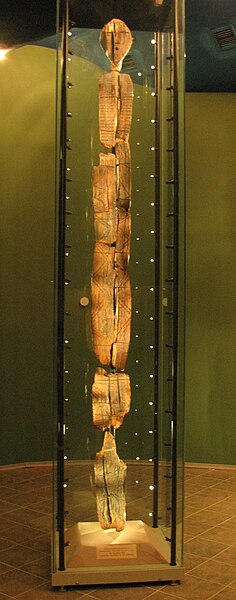The Ertebølle culture is a hunter-gatherer and fisher, pottery-making culture dating to the end of the Mesolithic period. The culture was concentrated in Southern Scandinavia. It is named after the type site, a location in the small village of Ertebølle on Limfjorden in Danish Jutland. In the 1890s the National Museum of Denmark excavated heaps of oyster shells there, mixed with mussels, snails, bones, and artefacts of bone, antler, and flint, which were evaluated as kitchen middens, or refuse dumps. Accordingly, the culture is less-commonly named the Kitchen Midden. As it is approximately identical to the Ellerbek culture of Schleswig-Holstein, the combined name, Ertebølle-Ellerbek is often used. The Ellerbek culture is named after a type site in Ellerbek, a community on the edge of Kiel, Germany.
Ceramic boat model
Pottery
flake axe
A late Scandinavian Hunter-Gatherer, buried seated, dated circa 7,000 BP, from Skateholm, near Trelleborg in southwest Sweden. Reconstruction by Oscar Nilsson, Trelleborgs Museum.
The Mesolithic or Middle Stone Age is the Old World archaeological period between the Upper Paleolithic and the Neolithic. The term Epipaleolithic is often used synonymously, especially for outside northern Europe, and for the corresponding period in the Levant and Caucasus. The Mesolithic has different time spans in different parts of Eurasia. It refers to the final period of hunter-gatherer cultures in Europe and the Middle East, between the end of the Last Glacial Maximum and the Neolithic Revolution. In Europe it spans roughly 15,000 to 5,000 BP; in the Middle East roughly 20,000 to 10,000 BP. The term is less used of areas farther east, and not at all beyond Eurasia and North Africa.
Reconstruction of a "temporary" Mesolithic house in Ireland; waterside sites offered good food resources.
The Mesolithic begins during the latest Pleistocene, characterized by a progressive rise of temperatures, between the end of the Last Glacial Maximum and the Neolithic Revolution during the Holocene. Evolution of temperature in the Post-Glacial period according to Greenland ice cores.
Mesolithic artifacts
The Shigir Idol, from the east of the Ural mountains.








